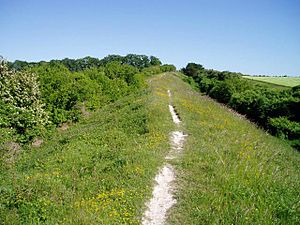Fleam Dyke facts for kids
| Site of Special Scientific Interest | |

Fleam Dyke approaching Mutlow Hill
|
|
| Area of Search | Cambridgeshire |
|---|---|
| Interest | Biological |
| Area | 7.8 hectares |
| Notification | 1984 |
| Location map | Magic Map |
Fleam Dyke is a very old, long earthwork in Cambridgeshire, England. It stretches between the villages of Fulbourn and Balsham. Today, it is a special protected area called a Scheduled Monument. It is also a 7.8-hectare Site of Special Scientific Interest, which means it's important for its wildlife. Long ago, it marked a boundary for an old Anglo-Saxon area called Flendish Hundred.
Contents
What is Fleam Dyke?
Fleam Dyke is a huge bank of earth with a ditch next to it. It was built a very long time ago. This earthwork is about seven metres high. It runs all the way from Fulbourn to Balsham. Most of this ancient structure still exists today. You can even walk along parts of it, as it is now a public footpath.
A Look Back in Time: Its History
For many years, people thought Fleam Dyke was built around the 600s. They believed it was a defence for the Kingdom of East Anglia. This was during their wars with Mercia, another powerful kingdom. In the 1800s and early 1900s, old Anglo-Saxon weapons and burials were found here. These discoveries made people think it was a battle line.
However, new discoveries changed this idea. In 1991, archaeologists dug up parts of the dyke. They found that it was built in different stages. The first part was made between 330 and 510 AD. The last part was added between 450 and 620 AD. Now, experts think it was most likely built by early Anglo-Saxon settlers. They probably built it in the 400s. It was a defence against the Romano-British people. These people were trying to get their land back after the Romans left Britain.
At a place called Mutlow Hill, the dyke goes through a Bronze Age burial mound. This mound is called a barrow. Later, during the Roman period, this barrow was used again. It became a temple.
How Fleam Dyke Was Built
Fleam Dyke is one of four large earthworks in this area. Each of these earthworks has a high bank. They also have a ditch on their southwest side. They all cross a chalk ridge in south Cambridgeshire. This ridge is where the famous Icknield Way runs. The other similar earthworks are Devil's Dyke, Brent Ditch, and Bran Ditch.
The Icknield Way was a very important route in history. It is a path that existed even before the Romans came to Britain. Many people say it is the oldest road in England. In medieval times, it was named one of the "Four Highways" of England. Travellers on these highways had special royal protection. So, Fleam Dyke, along with Flendish Hundred and Fulbourn, has a special place in history.
Wildlife and Nature at Fleam Dyke
Fleam Dyke is a very important place for nature. Between 1912 and 1915, a man named Charles Rothschild chose it as a special wildlife site. He picked 286 sites in Britain and Ireland that were "worthy of preservation."
The sides of the earthwork are very steep. They have a special type of habitat called species-rich chalk grassland. This kind of grassland is quite rare in Cambridgeshire. The dyke is kept healthy by regular grass cutting. It is also the only place in Cambridgeshire where you can find the common juniper plant growing naturally.
A long-distance walking path called the Harcamlow Way goes right through Fleam Dyke. This allows people to explore its history and enjoy its unique nature.

